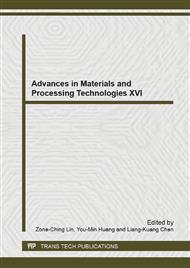p.305
p.313
p.322
p.328
p.336
p.342
p.349
p.355
p.361
Influence of Wire Reinforcement on the Forming Behaviour of Adhesive Bonded Steel Sheets
Abstract:
A method for modifying the properties of adhesives is by the addition of metallic wire strand in fibre form to improve the thermal conductivity for use in electrical applications. Clearly any advantage gained as far as thermal conductivity is concerned should not be counteracted by deficiencies in mechanical properties. In this work, the influence of copper wire reinforcements on the tensile behaviour of adhesive bonded steel sheets will be presented. The adhesive used is a two-part epoxy resin with a mix ratio of 1:1 parts by weight of resin to hardener. Wire strands used are copper wires having a diameter of 0.3 mm. The base materials are made of Stainless Steel. The stress-strain behaviour, and limit strain are evaluated through tensile tests and in-plane plane-strain (IPPS) formability tests. It is found that the ductility and limit strain of adhesive bonded sheets with wire reinforcement are better than that of the case without reinforcement. The ductility and limit strain of wire reinforced adhesive bonded sheets increases till three wires in the case of tensile tests, and four wires in the case of IPPS formability tests, after which it decreases.
Info:
Periodical:
Pages:
336-341
Citation:
Online since:
May 2014
Authors:
Price:
Сopyright:
© 2014 Trans Tech Publications Ltd. All Rights Reserved
Share:
Citation:


